Venus flytraps ( Dionaea muscipula ) are fascinating carnivorous plants that captivate plant enthusiasts of all ages. Their unique trapping mechanism and predatory nature make them a popular choice for home growers. A common question for both beginners and experienced growers alike is: what can I feed my Venus fly trap to ensure its health and vigorous growth?
Just like any living organism, Venus flytraps require proper nutrition to thrive. While they can obtain some nutrients through photosynthesis, feeding them insects or suitable alternatives significantly boosts their growth rate and overall vitality. In this guide, we’ll delve into the best food options for your Venus flytrap, focusing on practical techniques to maximize their nutritional intake and accelerate their journey from seedling to adult plant.
From Seed to Supper: Why Feeding Matters from the Start
Even from the moment they sprout, Venus flytrap seedlings are carnivorous. Those tiny first traps are ready to hunt, albeit for minuscule prey. Providing nourishment right from the seedling stage gives your Venus flytrap a significant head start. Think of it as providing the best possible early life nutrition – a strong start sets the stage for rapid and robust development.
Getting Started: Germination and Early Growth
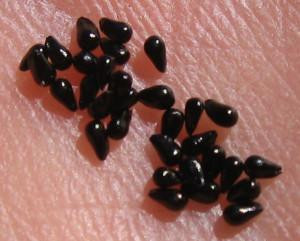 Handful of Venus Flytrap Seeds
Handful of Venus Flytrap Seeds
A handful of Venus flytrap seeds, ready for sowing and the start of a new carnivorous plant life.
Starting with high-quality Venus flytrap seeds is crucial for successful and rapid growth. Strong germination is the foundation for healthy seedlings that can readily benefit from feeding.
Similar to providing a nutritious foundation for any young life, giving baby Venus flytraps optimal conditions and food from the beginning allows them to maintain a rapid growth trajectory, becoming stronger and more resilient from their earliest stages.
For germination, long-fiber sphagnum moss (either dead or living) provides an ideal medium. Simply sprinkle the seeds on the surface – do not bury them, as they need light to germinate. Maintain high humidity and relatively warm temperatures for optimal sprouting. A temperature range of 30°C (day) to 25°C (night) mimics their native “lowland conditions” and promotes quick germination. Using a plastic dome or terrarium helps maintain the necessary high humidity levels.
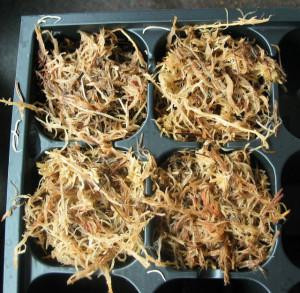 Flytrap Seed Sowing
Flytrap Seed Sowing
Sowing Venus flytrap seeds on sphagnum moss. Seeds should be sprinkled on the surface and not buried to ensure proper germination.
Germination typically occurs within 10 to 20 days under ideal conditions, but it may take longer if conditions are less than perfect. Maintaining a very high relative humidity, ideally between 90% and 100%, is key to faster germination and robust seedling development. While some growers reduce humidity to combat algae and fungal growth, high humidity mirrors their natural habitat and encourages faster seedling growth.
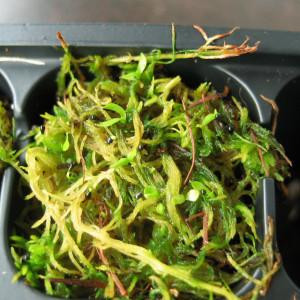 Venus Flytrap Seed Germination
Venus Flytrap Seed Germination
Venus flytrap seeds after germination. Notice the tiny traps beginning to form, ready to capture small prey.
Within the first couple of weeks after germination, you’ll observe the development of the first tiny, square-shaped traps. These miniature traps are fully functional and ready to capture prey. It’s at this stage, immediately after the first trap opens, that feeding becomes crucial for maximizing growth.
The Nutritional Powerhouse: Freeze-Dried Bloodworms
To answer the question “What Can I Feed Venus Fly Trap?”, freeze-dried bloodworms emerge as an excellent choice, especially for young plants. Let’s understand why.
Venus flytraps, related to sundews ( Drosera ), evolved their sophisticated trapping mechanism to efficiently extract nutrients from prey. Unlike sundews that rely on sticky leaves to capture primarily flying insects, Venus flytraps developed closed traps to maximize nutrient absorption, particularly nitrogen, which is often scarce in their nutrient-poor native environment. Crawling insects generally offer a richer source of nitrogen compared to flying insects.
This is where freeze-dried bloodworms come into play. They are exceptionally rich in crude proteins and nitrogen, providing a concentrated nutritional boost that propels the Venus flytrap’s growth.
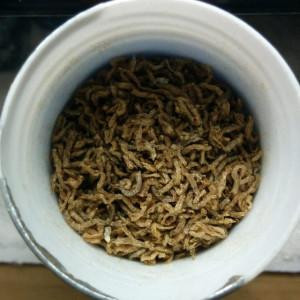 Dehydrated Blood Worms
Dehydrated Blood Worms
Freeze-dried bloodworms, a highly nutritious food source for Venus flytraps and other carnivorous plants.
While large-scale nurseries may opt for foliar fertilization or diluted fertilizer in the soil to supplement nutrients, hand-feeding offers a targeted and highly effective approach, especially for home growers who want to maximize the growth rate of their plants. In vitro propagation (tissue culture) is another method used commercially to accelerate growth in a sterile environment, but for home cultivation, direct feeding is a readily accessible and rewarding technique.
 Pot of young, hungry Venus Flytraps
Pot of young, hungry Venus Flytraps
A pot of young, hungry Venus flytrap seedlings eagerly awaiting their nutrient-rich meal.
Step-by-Step Guide: Feeding Your Venus Flytrap Bloodworms
Feeding Venus flytraps with freeze-dried bloodworms is a straightforward process:
-
Rehydrate the Bloodworms: Soak the freeze-dried bloodworms in a small amount of water until they become soft and pliable. This rehydration makes them easier for the plant to digest and mimics the moisture content of live prey.
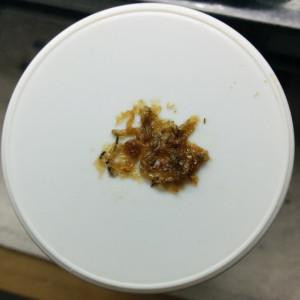 Rehydrating Freeze-Dried Blood Worms
Rehydrating Freeze-Dried Blood Worms
Rehydrating freeze-dried bloodworms in water, preparing them to be a palatable meal for Venus flytraps. -
Form Small “Meatballs”: Remove excess water from the rehydrated bloodworms and roll them into tiny balls. The size of these “meatballs” is crucial – they should be no larger than one-third the size of the Venus flytrap’s trap. Overly large food pieces can lead to trap rot and damage.
-
Use a Toothpick for Precision Feeding: Place a bloodworm meatball on the tip of a toothpick. Gently insert the toothpick into an open trap, positioning the meatball inside.
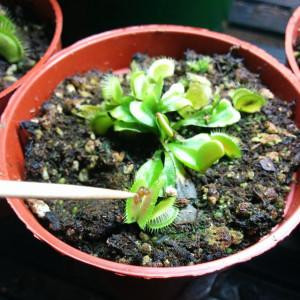 Feed a Venus flytrap
Feed a Venus flytrap
Using a toothpick to carefully place a rehydrated bloodworm “meatball” into an open Venus flytrap trap. -
Trigger the Trap: Gently move the toothpick inside the trap to stimulate the trigger hairs. This will cause the trap to snap shut. Be patient, as seedling traps may close more slowly than those of mature plants.
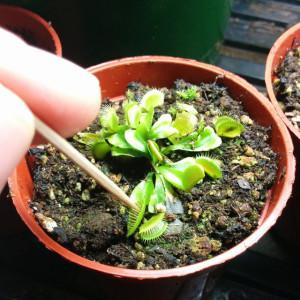 Feeding a young Venus Fly Trap
Feeding a young Venus Fly Trap
Ensuring the trap is triggered to close around the bloodworm, initiating the digestion process. -
Encourage Sealing and Digestion: Venus flytraps typically seal their traps after catching live prey due to the prey’s movement stimulating the trigger hairs further. Since we’re feeding non-living bloodworms, we need to mimic this stimulation. Gently massage the sides of the closed trap with two toothpicks, forceps, or even your fingertips. This simulates the movement of a struggling insect, prompting the trap to seal tightly and begin digestion. If the trap doesn’t seal within about 30 minutes, repeat the gentle massage.
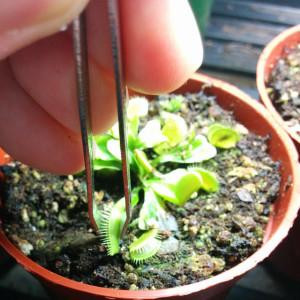 Feeding a young Venus Fly Trap
Feeding a young Venus Fly Trap
Gently massaging the sides of the trap to encourage it to seal, mimicking the movement of live prey and initiating digestion. -
Observe Digestion: Once sealed, the trap will remain closed for several days, typically around 5 days in warm conditions, while digestion occurs.
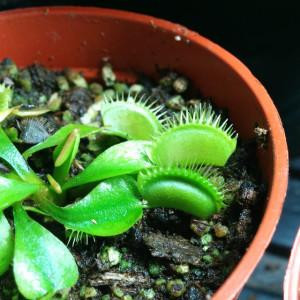 Sealed and Digesting Young Venus Flytrap
Sealed and Digesting Young Venus Flytrap
A sealed Venus flytrap trap, indicating that digestion of the bloodworm meal is underway.
A healthy Venus flytrap trap can typically digest 2 to 4 meals before it becomes inactive. Even after a trap loses its snapping ability, it continues to photosynthesize as long as it remains green, so avoid removing live but inactive traps.
For optimal growth, aim to feed one or two traps per plant per week. This consistent feeding regimen will visibly accelerate your Venus flytrap’s growth.
 Quickly Growing Young Venus Flytraps
Quickly Growing Young Venus Flytraps
A thriving group of young Venus flytraps, exhibiting rapid growth thanks to regular feeding.
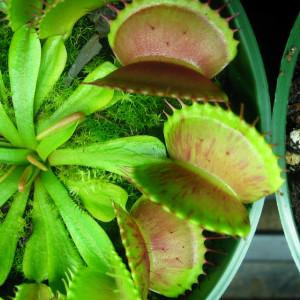 Nearly Adult-sized Venus Flytraps
Nearly Adult-sized Venus Flytraps
Venus flytraps approaching adult size, demonstrating the effectiveness of consistent feeding in promoting robust growth.
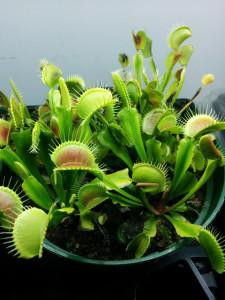 Nearly Adult-sized Venus Flytraps
Nearly Adult-sized Venus Flytraps
Close-up view of nearly adult-sized Venus flytraps, showcasing healthy trap development and vibrant color.
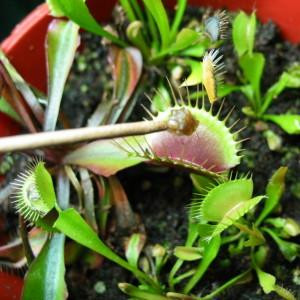 Nearly Adult-sized Venus Flyfraps
Nearly Adult-sized Venus Flyfraps
Even larger Venus flytraps benefiting from a meal of rehydrated bloodworms, demonstrating the feeding technique on mature plants.
Ideal Growing Conditions for Venus Flytraps
Alongside proper feeding, providing the right growing conditions is paramount for maximizing your Venus flytrap’s growth potential. Here are key factors to consider:
- Humidity: Maintain consistently high humidity around 80%.
- Temperature: Ideal daytime temperatures are around 24°C (75°F), with nighttime lows of 18°C (65°F). After feeding, slightly increase the daytime temperature to 28°C (82°F) for about 48 hours to aid digestion.
- Light: Venus flytraps require intense light. Use high-output T5 fluorescent tubes with a full spectrum, providing a 16-hour photoperiod (16 hours of light, 8 hours of darkness). Consider adding blue spectrum (2700K) vertical tubes to enhance growth.
- Airflow: Gentle airflow around the plants is beneficial.
- Soil: Use a well-draining, nutrient-poor soil mix. A suitable blend is 50% peat moss, 25% perlite, and 25% coconut husk chunks.
- Watering: Water thoroughly twice a week from the top using distilled water, rainwater, or reverse osmosis water. Avoid tap water and mineral water, as the minerals can be harmful.
Beyond Venus Flytraps: Feeding Other Carnivorous Plants
Freeze-dried bloodworms are not only excellent for Venus flytraps but also for feeding many other carnivorous plant genera, including Heliamphora, Cephalotus, Nepenthes, and some Sarracenia species.
For pitcher plants like Heliamphora, Nepenthes, and Sarracenia, the “dusting method” works well: simply dust dry freeze-dried bloodworms into their pitchers. Alternatively, you can use rehydrated bloodworms and deposit them into the pitchers using a toothpick, similar to feeding Venus flytraps.
 Feeding Heliamphora Dehydrated Blood Worms
Feeding Heliamphora Dehydrated Blood Worms
Feeding Heliamphora pitcher plants by dusting dry freeze-dried bloodworms directly into their pitchers.
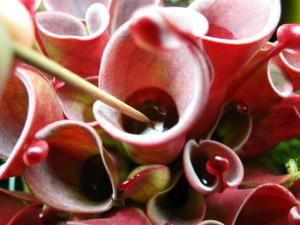 Feeding Heliamphora Dehydrated Blood Worms
Feeding Heliamphora Dehydrated Blood Worms
Another view of feeding Heliamphora, showing the ease of dusting bloodworms into the pitcher opening.
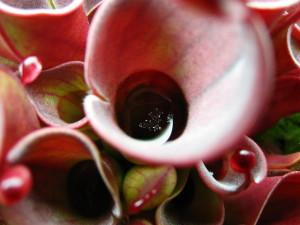 Feeding Heliamphora Dehydrated Blood Worms
Feeding Heliamphora Dehydrated Blood Worms
Close-up of bloodworms inside a Heliamphora pitcher, providing essential nutrients to the plant.
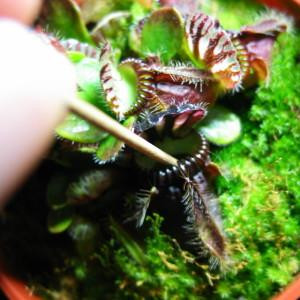 Feeding Cephalotus Dehydrated Blood Worms
Feeding Cephalotus Dehydrated Blood Worms
Feeding Cephalotus follicularis, the Albany pitcher plant, with freeze-dried bloodworms.
For butterworts (Pinguicula), the dusting method is also effective. Lightly dust powdered freeze-dried bloodworms onto their sticky leaves.
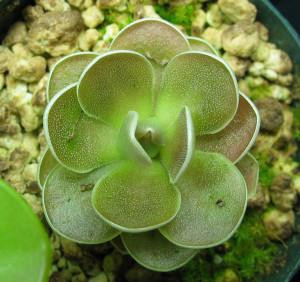 Feeding Pinguicula Dehydrated Blood Worms
Feeding Pinguicula Dehydrated Blood Worms
Feeding Pinguicula, or butterworts, by dusting powdered freeze-dried bloodworms onto their sticky leaves.
For certain genera like Utricularia and Genlisea, feeding can be challenging. For Sarracenia minor, it is also somewhat difficult to feed directly. In some cases, grinding the freeze-dried bloodworms into a finer powder can aid digestion for more delicate carnivorous plants.
Conclusion: Unlocking Rapid Growth with Targeted Feeding
Freeze-dried bloodworms are readily available in pet stores and online retailers, typically sold as fish food. They offer a cost-effective, convenient, and highly rewarding method for accelerating the growth of your Venus flytraps and other carnivorous plants.
A Word of Caution: Some individuals are allergic to freeze-dried bloodworms. Exercise caution and use toothpicks or tools to avoid direct skin contact.
By understanding what can i feed venus fly trap and implementing a consistent feeding strategy with freeze-dried bloodworms, combined with optimal growing conditions, you can witness remarkable growth and enjoy the fascinating carnivorous nature of your plants to the fullest.
External Link:
- Barry Rice’s page on Feeding a Venus flytrap: http://www.sarracenia.com/faq/faq2460.html